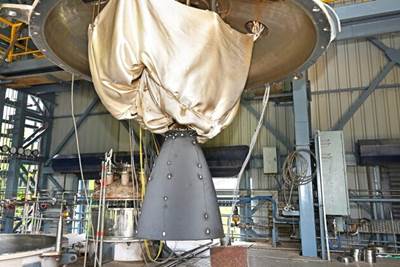Venus Aerospace makes headway on scaling RDRE hypersonic engine
More compact and agile hypersonic rocket engine propulsion system, supported by a NASA SBIR, will be demonstrated in the summer.
RDRE hot fire test. Source | Venus Aerospace
(Houston, Texas, U.S.), an aerospace startup building advanced engine systems for hypersonic flight, has successfully completed a technological advancement supported by a NASA Small Business Innovation Research (SBIR) award — new nozzle designs — that, having exceeded expectations, will outfit Venus’ hypersonic rocket engine system during an upcoming flight demonstration later in summer 2025.
“We’ve already proven our engine outperforms traditional systems on both
efficiency and size,” says CEO Sassie Duggleby. “The technology we developed
with NASA’s support will now be part of our integrated engine platform —bringing us one step closer to proving that efficient, compact and affordable hypersonic flight can be scaled.”
The engine at the center of Venus’s flight platform is a rotating detonation
rocket engine (RDRE), a system that the company says has been long considered promising but never proven at scale, at least until now. Unlike conventional rocket engines, the Venus RDRE operates through supersonic shockwaves — called detonations —that generate more power with less fuel.
“This is just the beginning of what can be achieved with Venus propulsion
technology,” says Andrew Duggleby, Venus Aerospace CTO. “We’ve built a
compact, high-performance system that unlocks speed, range and agility across aerospace, defense and many other applications. And we’re confident in its readiness for flight.”
This summer’s flight will mark a significant milestone in demonstrating Venus’ engine at scale, building on a series of advances at Venus Aerospace. In fall 2024,the company unveiled a high-speed engine system that enables takeoff, acceleration and hypersonic cruise — all powered by a single engine architecture.
While most high-speed systems require multiple engines to operate at different speeds, Venus says its approach eliminates the cost, weight and complexity of traditional propulsion technology. The system delivers rocket-like takeoff power and jet-like cruise efficiency, and it enables a vehicle to accelerate from runway to Mach 5+ without changing engines.
The Venus system supports a wide range of applications, including spacecraft landers, low-Earth orbit satellite, space cargo transfer vehicles, rocket kick-stages and hypersonic drones and missiles.
Related Content
First Airbus A350 crash confirmed in Haneda
Shortly after touch-down, a JAL A350-900 aircraft recently collided with a De Havilland Canada Dash 8. Exact circumstances are still unknown.
Read MoreThe potential for thermoplastic composite nacelles
Collins Aerospace draws on global team, decades of experience to demonstrate large, curved AFP and welded structures for the next generation of aircraft.
Read MorePlant tour: Airbus, Illescas, Spain
Airbus’ Illescas facility, featuring highly automated composites processes for the A350 lower wing cover and one-piece Section 19 fuselage barrels, works toward production ramp-ups and next-generation aircraft.
Read MoreIndustrializing additive manufacturing in the defense/aerospace sector
GA-ASI demonstrates a path forward for the use of additive technologies for composite tooling, flight-qualified parts.
Read MoreRead Next
Toyota invests in Interstellar, enters reuseable launch rocket market
A deepened strategic alliance with the Japanese startup will combine Toyota’s automotive expertise and Interstellar’s CFRP know-how for mass rocket production.
Read MoreReaction Dynamics earns CSA grant for composite propellant tanks, hybrid rocket fuel
The $1.5 million grant boosts the Canadian company’s goal to advance its Aurora orbital launch vehicle program.
Read MoreISRO C/C composite nozzle development enhances rocket engines
Durable composite nozzle can replace metal versions for mass reduction and payload capacity boost in launch vehicles.
Read More












